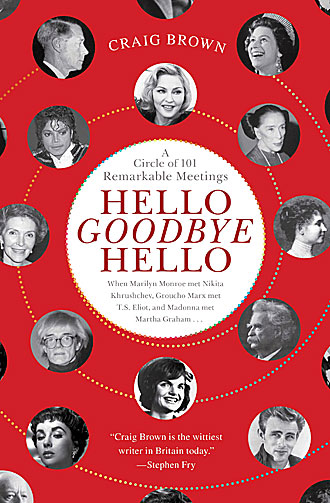Encounters

Hello Goodbye Hello:
A Circle of 101 Remarkable Meetings
By Craig Brown
Simon & Schuster, 2012
A Bintel Brief:
Sixty Years of Letters from the Lower East Side to the Jewish Daily Forward
By Isaac Metzker
Schocken Books, 1971
Hello Goodbye Hello is, according to the book jacket, “a circle of 101 remarkable meetings,” and indeed it is. Each of the meetings portrayed in the book is between two interesting people, most of whom you would not connect with each other. It is not fiction. No meeting is more than three pages long and the writing is simple and elegant, but the content is complex and sometime troubling—these encounters are best used in the context of high school. Some are loving, others violent, but each one is a beautifully rendered and provoking conversation. As a reader, I felt I was having a peek into the authentic lives of strangers.
Here is a short sampler of the encounters in the book with the delightful titles provided by author Craig Brown:
“Salvador Dalí sketches Sigmund Freud”
“Charlie Chaplin plays straight man to Groucho Marx”
“Groucho Marx wants to be taken seriously by TS Eliot”
“Martha Graham silences Madonna”
One of my favorite selections is Helen Keller’s encounter with Martha Graham. In the course of the conversation Helen Keller asks Martha Graham, “Martha, what is jumping? I don’t understand.” They are at a rehearsal, and Helen Keller can only feel the sound of dancing in the studio.
Graham draws upon the skills of her student Merce Cunningham. She asks him to stand at the barre in her studio and puts Helen Keller’s hands on his waist. Then Cunningham jumps as Keller’s hands rise and fall with his body. He performs small leaps with her holding on and “she is experiencing dance.” “How like thought,” Keller says. “How like the mind it is!”
That is wonderful teaching, without needing a word or a lesson plan—just sensitivity, intuition, and intelligence. We can always use more of that in our work with children.
Recently, Dear Abby died at the age of 92. She was born Pauline Esther Friedman. She and her identical twin, Esther Pauline Friedman, were born in Sioux City, Iowa, to Russian Jewish immigrant parents in 1918. They became pioneers in writing popular advice columns as Abigail Van Buren and Ann Landers. They were both masters at pithy, unsentimental advice. They offered direct, no-nonsense responses to sensitive questions—often with a dose of humor and a pinch of cynicism. It is what I call the Yiddish in them.
I’ve seen media claims that they created this genre, but the first advice column I have found was A Bintel Brief, an advice column in the Jewish Daily Forward, a Yiddish-language newspaper published in the United States beginning in 1906, during the great East European Jewish migration. Yiddish was the language of Russian Jews. A Bintel Brief had the same form as the Dear Abby and Ann Landers columns, and much the same tone to the answers. The issues were focused on advice to immigrants coming to a new world, but I find they still resonate.
A letter from 1906 begins: “Honorable Editor, I have a grievous wound in my heart and maybe through the Bintel Brief will find relief. . . .”
Other letters (both from 1914) start: “I am old woman of 70, write you with my heart’s blood, because I am distressed” and “I am a girl, 22 years of age, but I’ve already undergone a great deal in my life.”
These are just teasers. If you would like to read the answers, have a historical adventure, and learn good folk psychology, I urge you to get copy of the collection A Bintel Brief.

